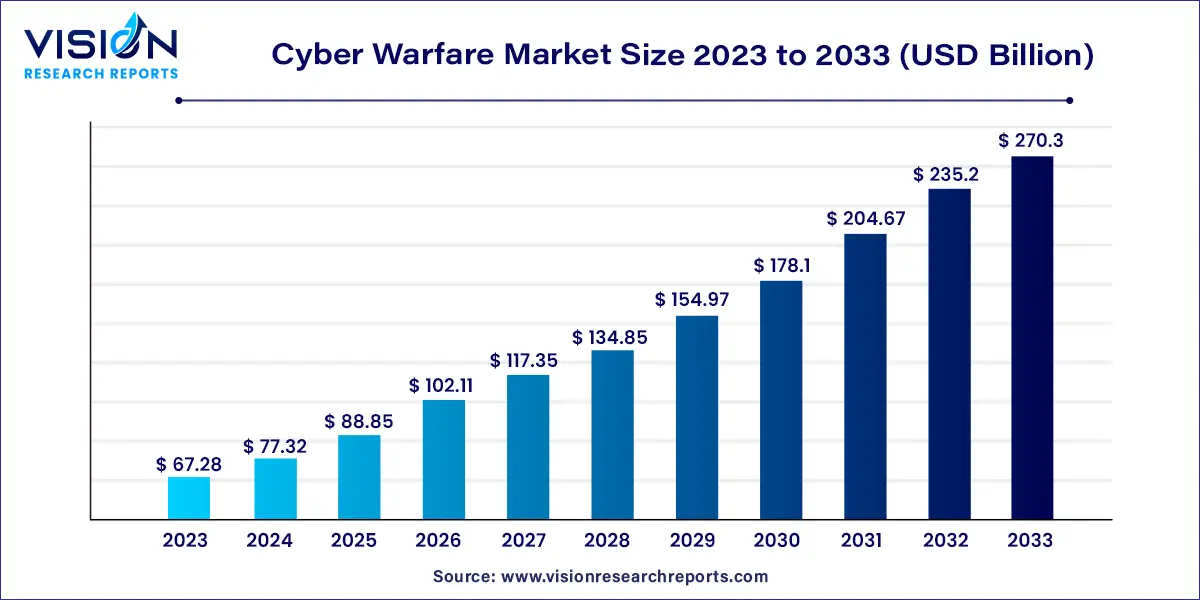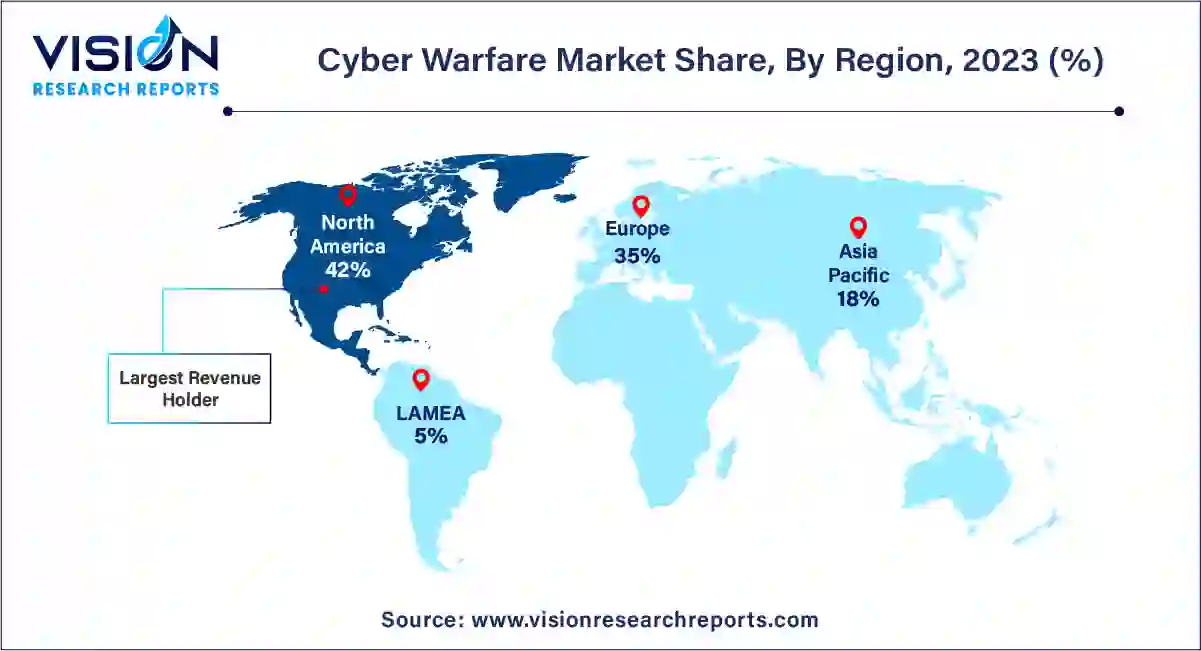The global cyber warfare market size was estimated at around USD 67.28 billion in 2023 and it is projected to hit around USD 270.3 billion by 2033, growing at a CAGR of 14.92% from 2024 to 2033.

Cyber warfare, a term that once belonged to science fiction, is now a stark reality shaping the future of conflicts worldwide. This overview delves into the intricate layers of the cyber warfare market, providing insights into its evolution, key players, challenges, and the transformative impact on global security paradigms.
The exponential growth of the cyber warfare market can be attributed to several key factors. Firstly, the increasing frequency and sophistication of cyber-attacks across various sectors, including government, finance, and critical infrastructure, have propelled the demand for advanced cybersecurity solutions. Secondly, the rising adoption of cloud computing, IoT devices, and interconnected networks has expanded the attack surface, necessitating robust defense mechanisms. Additionally, stringent regulatory mandates and compliance requirements have prompted organizations to invest in cybersecurity measures, further fueling market growth. Moreover, the escalation of geopolitical tensions and state-sponsored cyber-espionage activities have led nations to enhance their cyber capabilities, contributing significantly to market expansion. Furthermore, the growing awareness about the financial and reputational consequences of cyber-attacks has driven businesses to allocate substantial budgets for cybersecurity, fostering market development. Lastly, advancements in artificial intelligence and machine learning technologies are empowering cybersecurity solutions, enabling proactive threat detection and mitigation, thereby fostering market growth organically.
| Report Coverage | Details |
| Revenue Share of North American in 2023 | 42% |
| CAGR of Asia Pacific from 2024 to 2033 | 17.48% |
| Revenue Forecast by 2033 | USD 270.3 billion |
| Growth Rate from 2024 to 2033 | CAGR of 14.92% |
| Base Year | 2023 |
| Forecast Period | 2024 to 2033 |
| Market Analysis (Terms Used) | Value (US$ Million/Billion) or (Volume/Units) |
The defense segment held the largest revenue share of 32% in 2023. In defense, cyber warfare techniques are deployed to protect military networks, communication systems, and classified information from unauthorized access and cyber-attacks. Advanced encryption methods and secure communication protocols are employed to ensure the confidentiality and integrity of sensitive military data. Furthermore, cyber warfare capabilities enable military forces to conduct intelligence gathering, monitor adversaries' activities, and anticipate potential threats in the digital domain, thereby enhancing strategic decision-making processes.
The government application segment is expected to grow at the fastest CAGR of 15.47% during the forecast period. In the governmental sphere, cyber warfare technologies play a crucial role in safeguarding national interests and critical infrastructure. Governments utilize these technologies to defend against cyber threats aimed at disrupting essential services, such as energy grids, transportation networks, and financial systems. By implementing robust cybersecurity measures, governments can mitigate the risks posed by cyber-attacks, ensuring the smooth functioning of public services and preserving the trust of their citizens. Additionally, cyber warfare tools are employed for cyber espionage and reconnaissance, allowing governments to gather valuable intelligence on other nations, terrorist organizations, and cybercriminal networks, thereby strengthening their national security posture.
The corporate segment is predicted to grow at the remarkable CAGR of 16.18% over the forecast period. In the corporate landscape, the applications of cyber warfare technologies have become essential components of modern business strategies. Corporations across various industries heavily depend on digital platforms, cloud services, and interconnected networks to operate efficiently. As a result, ensuring the security and integrity of sensitive corporate data has become paramount. Cyber warfare technologies are employed to establish robust cybersecurity protocols, safeguarding intellectual property, customer information, and financial data from unauthorized access and cyber-attacks. Advanced encryption methods and intrusion detection systems are deployed to create secure perimeters, ensuring the confidentiality of corporate communications and transactions.
The North American region held the largest revenue share of 42% in 2023. In North America, particularly in the United States, significant emphasis is placed on cybersecurity initiatives due to the country's status as a technological powerhouse and a prime target for cyber-attacks. The U.S. government, along with private enterprises, invests heavily in research and development, fostering innovation in cybersecurity technologies. The region is also home to numerous cybersecurity firms, contributing to the overall growth of the market. Similarly, Canada demonstrates a proactive approach to cybersecurity, aligning its efforts with international standards to ensure the resilience of its digital infrastructure.

Asia Pacific is estimated to grow at the fastest CAGR of 17.48% from 2024 to 2033. Asia-Pacific, being a diverse region, showcases varying approaches to cyber warfare. In technologically advanced nations like Japan and South Korea, substantial investments are made in cybersecurity research, development, and education. These countries focus on fostering cybersecurity talent and innovation. China, with its robust cyber capabilities, is a key player in the global cyber warfare arena, both in terms of defense and offense. In Southeast Asia, countries are increasingly recognizing the importance of cybersecurity, implementing measures to combat cyber threats and enhance their digital resilience.
By Application
By Region
 Cross-segment Market Size and Analysis for
Mentioned Segments
Cross-segment Market Size and Analysis for
Mentioned Segments
 Additional Company Profiles (Upto 5 With No Cost)
Additional Company Profiles (Upto 5 With No Cost)
 Additional Countries (Apart From Mentioned Countries)
Additional Countries (Apart From Mentioned Countries)
 Country/Region-specific Report
Country/Region-specific Report
 Go To Market Strategy
Go To Market Strategy
 Region Specific Market Dynamics
Region Specific Market Dynamics Region Level Market Share
Region Level Market Share Import Export Analysis
Import Export Analysis Production Analysis
Production Analysis Others
Others